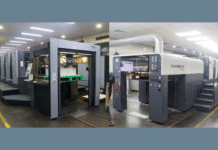
At the Printpack exhibition, we met with Ricoh Graphics Communication Products’ president Koji Miyao at the Monotech stand. He was direct and forthcoming about the company’s outlook on the global print industry and the progress of digital print in each region. He expressed the company’s long-term commitment to the Indian market as it develops and increasingly aligns with global automation and print trends. Excerpts from the conversation with editor Naresh Khanna follow.
Naresh Khanna – What is your global perspective of the transition to digital print?
Koji Miyao – From our perspective over the past five years, we have been growing. North America and Europe have been growing the fastest in digital printing, followed by South Korea, China, Taiwan, and India will come after that. Within Asia, Japan lags somewhat behind America and Europe in terms of small lot suitability for offset printing where there are issues to be addressed in developing a business model more suitable for digital printing.
Among the printing companies in Europe, there is some consolidation and in America there is a bit of a slowdown for toner-based digital while there is a growth in high-speed inkjet printers. However, in China, there is growth in both toner-based and high-speed inkjet printers.
As for the outlook for Ricoh in India, since we are more in the mid-range to high-end digital production printer market – we are doing well with our two recently launched toner-based new products – the 7500 and the 9500. The 7500 is doing very well here and the 9500 will also catch up. The 9500 is doing very well globally and we have the number one market share in that category of digital production presses.
NK – What about high–speed inkjet for India? At drupa24 Ricoh showed the Z75 B2 sheetfed inkjet and the VC40000 and you have recently launched the higher capability VC80000. When or how can your high-speed inkjet technology be appropriate for India?
Koji Miyao – The VC40000 is a successful model, and globally we sell more than a hundred machines every year. However, we believe the Indian market will align more with our inkjet portfolio over the next 3 to 8 years. You could say that our plan and project for India are over the next ten years.
A few years ago, China was a growth market for us and now we are looking at the Indian market. We are trying to realize a unique Indian presence. Our deep commitment is to the overall digital transition that would include automation and information and communication technology (ICT). We are not limited to providing production printers but also want to be a part of the comprehensive solutions that support the digital transformation of individual users.
NK – What about the recent influx of Asian-made web-inkjet presses to the Indian market – from Japan, China, and India itself? Will these customers eventually migrate to Ricoh’s inkjet presses?
Koji Miyao – You could say the market may move from lower to higher–end machines. Still, we feel there is a significant differentiation between us and them. In China, we are targeting the high-end segment of inkjet and this is going well.
We hope to do that in India. We don’t compete with the Chinese manufacturers, or even with Kodak, but we do compete with Canon. In addition, many inkjet web press manufacturers are customers of our inkjet heads. These are two different things, but we sell both machines and heads.
In terms of product mix, we have the world’s top market share in mid-range and high-end machines, covering low-end to mid-range and high-end products. Our product strength in specific fields is among the highest in the world, and in the inkjet field, we have the technology for heads and inks.
NK – What about the price of digital consumables? Toner and inkjet inks, do you think the prices of these should come down?
Koji Miyao – I believe that toner-based ink prices will continue to remain steady. Toner inks may require more innovation or volumes to come down. However, the prices of inkjet inks must come down to support much broader usage by Indian printers!
NK – Any other comments for our readers?
Koji Miyao – Many printers are struggling with creating efficient systems for short-run printing and we would like to help them in developing their internal processes and business models that are more suitable for the changeover to digital printing. These could perhaps be improved through technology or even our digital services. We are here in the Indian market for the long term – to be a part of the overall digital transition in culture and print.

















